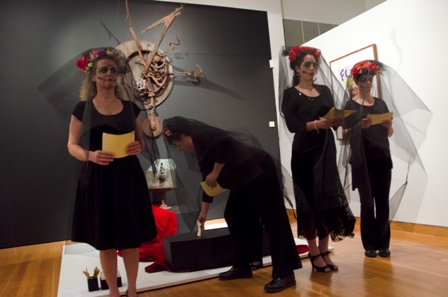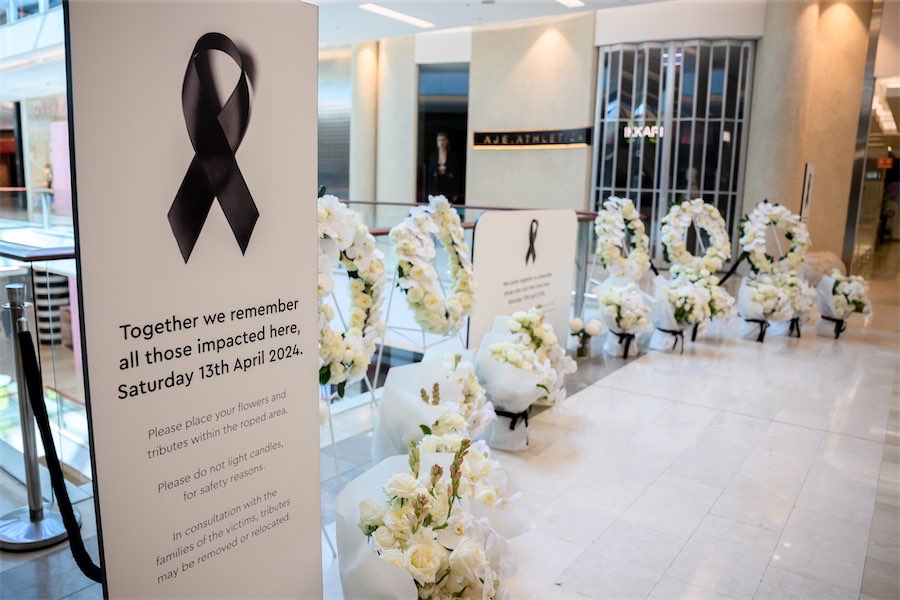THE EXHIBITION, “Splinters Theatre of Spectacle: massive love of risk,” now showing at the Canberra Museum and Gallery, is a poignant reminder of just how fragile our memories of recent history can be.

Anybody who lived through the Splinters era from the mid-80s to the 1990s will have particular memories of the group spearheaded by Patrick Troy, Stuart Vaskess and the late David Branson.
One local reviewer remembers the sense of sheer panic and claustrophobia as she tried to escape from the Splinters production of “Faust: the heat of knowledge” at University House in 1996.
For my part, apart from a memorable kaleidoscope of naked or phallus-clad young men rushing around with fiery torches on fiery vehicles, I can’t forget the Viking funeral the company staged by night in Weston Park, part of the production, “The Oracle”.
And indeed, with titles like “Cathedral of Flesh,” “Mysteries” and “Flowers of Gold,” the mysterious and oracular note was never far away from Splinters’ work, no matter how much showbiz they introduced into the mix.
Arising from art school and experimental theatre training mixed with a natural disposition towards anarchy, it was inevitable that Splinters should clash with the critics of the day. But the sheer joy in the company’s work overcame any finicky objections to its roughness, so that we read in The Canberra Times, that Splinters took the audience “on an extraordinary surreal imaginative flight”, and that the effect of the work was “like a big violent succulent strong dish that burns the roof of your mouth when you taste it; but when the laughter fades, sadness remains, and an uneasiness in a supernatural anguish.”
In Canberra’s Muse magazine, “Oracle” is described as “somewhere between a Cecil B DeMille epic and the Mahabharata” and the Sydney Morning Herald explained, “Splinters have gained enormous notoriety across Australia for their breathtaking special effects.”
The Canberra Critics’ Circle will pay tribute to the uneasy relationship its members enjoyed with Splinters in a symposium titled “Splinters: only in Canberra?” to be held at CMAG this Saturday afternoon.
The title is a reference to an exchange that took place when Splinters appeared at the old Adelaide Jail in 1992. “how can something like this come from Canberra?” somebody asked. Quick as a flash, the Splinters crowd responded, “it’s like this because it’s from Canberra!”
At a recent floor talk in the Canberra Museum and Gallery, curator Gavin Findlay explained the elements of the exhibition, praising CMAG curator Mark Bayly and his team for the high quality look of the show.
He and his co-curator Jose Robertson were at pains to overcome the dangers of staging a notional exhibition with little to show. To counter this, they introduced video imagery of, for instance, “Flowers of Gold” taken in 1992 at the old Kingston bus depot, Luhsun Tan’s 1992 video “Machine war,” that records the sculptural elements and the fire spectacle, and Splinters member Katherine Pepper’s video potpourri of photographic images. As well, there are four images of “Utopia/Distopia” on Springbank Island in 1995 by Canberra photographer ‘pling.
Among the several posters on display are founding member Vaskess’ 1989 poster for “Gumboot full of blood,” and posters by cartoonist Stephen Harrison and present-day associate professor of graphic design at the University of Canberra, Geoff Hinchliffe. “People now don’t realise the impact of outrageous posters,” Findlay says.
Two large “Snuff puppets” (the creator, Andy Freer went on with Pauline Cady and Simon Terrill to form company of the same name) sculpted for a 1990 Splinters performance based on Brecht’s “Mother Courage”.
Findlay, who later became manager of Splinters, admitted that he initially had an outsider’s view of Canberra, telling us “from a Sydney perspective Canberra was a regional backwater.” But he quickly understood that there was something about Canberra, with its well-educated and affluent population, that allowed “something like this to arise,” but he went on to write a series of formative articles about Splinters in a magazine RealTime.
“Now there’s a younger generation of artists that never saw the real thing and don’t always acknowledge the influence,” he says. Patrick Troy has estimated the number of people involved in Splinters at about 120, so the list of member/collaborators is enormous, including figures like Mikel Simic of Mikelangelo and the Black Sea Gentlemen.
In this exhibition, Findlay and Robertson aimed to “make Splinters come alive again.” One way of doing this was though costumes, but few survived for display, except a glorious dress created by Penny Sands and Pauline Cady in 1991 for “Winter of the Rutting Moon,” where the dress poured out like a pool of blood.
There is also a recovered (many sculptures were found rusting in paddocks) tricycle, “Trike #2,” created by Vaskess’ usual collaborator Adam Herbst, and a special installation by Findlay and Victoria Lees titled “Coffin,” a kind of memorial to Splinters, a part of which was carried ceremonially through CMAG on the opening night.
Being involved with Splinters was, according to Findlay, “exciting and dangerous, hard to explain, everything from soap operas to conflagration.”
Anarchistic in impetus, with lots of accidents in the early days, the company possibly became too big for its boots, as arts grants started pouring in and on and an administrative structure was deemed necessary. “It sort of fizzled out,” Findlay says.
In December 2001, one of the key founders, David Branson, died in a car accident on Anzac Parade. He is still mourned, even by theatre practitioners who never met him. Luckily, Branson kept all the Splinters papers in the flat at the back of his mother’s house, now the basis for scholarship and a new book in preparation by Joel Swadling.
As the corollary to the bold and brave, there is a darker side to Splinters which has scarcely been canvassed in the celebrations marking this exhibition. At least five members have died untimely deaths since the heyday of the company and in hindsight, there is a story to be told about the women who worked behind the scenes and onstage in a company that was always perceived as essentially masculine.
Still, the celebration is deserved, it seems. As Findlay puts it, “it was the most amazing outpouring of creativity I have ever seen.”
“Splinters: only in Canberra?” — A Canberra Critics Circle symposium on “Splinters Theatre of Spectacle”, November 2 from 1.30pm to 4pm at The Canberra Museum and Gallery Theatrette. FREE event. RSVP by Nov 1 to cmagbookings@act.gov.au or 6207 3968
Speakers will be:
Patrick Troy, one of the founders of Splinters.
Actor/Artist Renald Navilly on Splinters as a theatre process;
Curator, former Splinters member Gavin Findlay on the archiving of Splinters records;
Canberra author Joel Swadling on the biography he is writing about the late David Branson;
Educator/Theatre critic Frank McKone on the influence of ACT College arts and drama on the development of Splinters;
Assistant Professor Dr Geoff Hinchcliffe on the visual culture of Splinters; and
Canberra Critics Circle convener Helen Musa in the chair.
Who can be trusted?
In a world of spin and confusion, there’s never been a more important time to support independent journalism in Canberra.
If you trust our work online and want to enforce the power of independent voices, I invite you to make a small contribution.
Every dollar of support is invested back into our journalism to help keep citynews.com.au strong and free.
Thank you,
Ian Meikle, editor




Leave a Reply